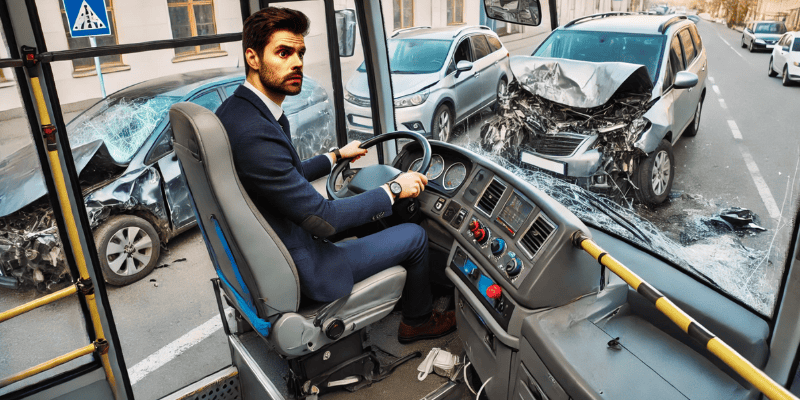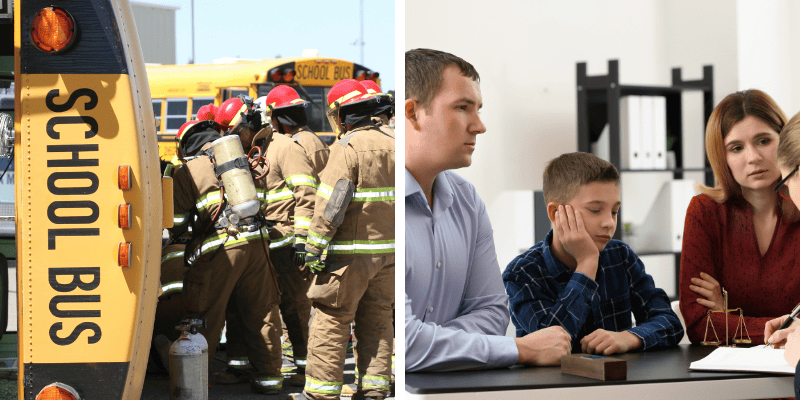4.9 Rating
Google REVIEWS
Leaders in Georgia Personal Injury Law Since 1995
Atlanta Bus Accident Lawyer
Seeking Justice with Scholle Law Car & Truck Accident Attorneys
Bus accidents in Atlanta can have devastating consequences, leaving victims with severe injuries, emotional trauma, and financial burdens. If you or a loved one has been involved in a bus accident, you deserve experienced and compassionate legal representation to help you navigate the complex legal process and secure the compensation you deserve. Scholle Law Car & Truck Accident Attorneys is here to provide that support, using our decades of experience to fight for your rights and ensure that justice is served.

Common Causes of Bus Accidents in Atlanta
Bus accidents can occur for various reasons, many of which are preventable. In Atlanta, some of the most common causes of bus accidents include:
- Driver Negligence: This can involve distracted driving, fatigue, speeding, or failure to follow traffic laws.
- Mechanical Failures: Poor maintenance can lead to brake failures, tire blowouts, or other mechanical issues that cause accidents.
- Poor Road Conditions: Potholes, inadequate signage, and poorly designed intersections can contribute to bus accidents.
- Weather Conditions: Atlanta’s weather, including heavy rain and fog, can make driving conditions hazardous, increasing the likelihood of accidents.
Understanding the cause of the accident is crucial in determining liability and pursuing compensation. Scholle Law Car & Truck Accident Attorneys has extensive experience investigating bus accidents and identifying the responsible parties.

Types of Bus Accidents
Bus accidents can involve different types of vehicles, each with unique legal considerations. Some of the most common types of bus accidents include:
- Public Transit Buses: Accidents involving city buses, such as MARTA, can involve complex claims against government entities.
- School Buses: Protecting children’s safety is paramount, and accidents involving school buses can lead to serious injuries.
- Private and Charter Buses: These buses are often used for tours, events, or private transport, with liability potentially involving multiple parties.
- Tour Buses: Accidents during tourist trips can involve out-of-state parties and complicated legal scenarios.
- Intercity Buses: Long-distance buses like Greyhound can lead to cross-jurisdictional issues, requiring experienced legal handling.
Public transportation carriers and commercial bus lines have a heightened duty to protect their passengers. In fact, it is firmly established under Georgia law that carriers of passengers have a duty to exercise “extraordinary diligence” to protect their passengers.
According to O.C.G.A. § 46-9-132:
“A carrier of passengers must exercise extraordinary diligence to protect the lives and persons of his passengers but is not liable for injuries to them after having used such diligence.”
Extraordinary diligence is defined under Georgia law as that extreme care and caution which very prudent and thoughtful persons exercise under the same or similar circumstances. Pursuant to this duty, a common carrier is liable for even slight negligence. What facts suffice to show the exercise of such extraordinary diligence is ordinarily a determination for a trial jury.
Bus lines are highly regulated and must comply with a whole host of regulations implemented under both state and federal law. They must also comply with their own operating guidelines and regulations common within the industry that, in some instances, can be more stringent than those imposed by law.
Commercial driving regulations and industry standards are both complex and voluminous, making it difficult if not impossible for the ordinary lay person to decipher and interpret and then appropriately apply to any given bus injury situation. This is true even when dealing with seemingly simple rules and regulations because they, in turn, are often subject to additional analysis based upon other regulatory provisions.
Therefore, in order to hold the bus lines accountable for such violations, it is often necessary to secure the services of a certified transportation expert who can evaluate the facts of the case and render an opinion as to the various rules, regulations, and laws that may have been violated. This serves to demonstrate the complexity of these sorts of cases and the importance of seeking advice from an experienced law firm.
Scholle Law Car & Truck Accident Attorneys is equipped to handle any type of bus accident case, ensuring that every detail is meticulously managed to maximize your compensation.

Bus Laws and Regulations Are More Nuanced
Bus injury cases are often complicated and involve nuanced laws and regulations. The Motor Carrier Safety Act of 1984 expanded the authority of the United States Department of Transportation to regulate the safety of interstate transportation of passengers by commercial motor vehicles (including buses). On January 1, 1995, private motor carriers of passengers (PMCPs) became subject to the Federal Motor Carrier Safety Regulations for the first time.
The transportation of pre-primary, primary, and secondary school children from home to school and from school to home, or any transportation performed by a governmental agency such as a public school district, is not subject to the Federal Motor Carrier Safety Regulations. However, they are subject to state and local laws and regulations as explained more fully below.
Therefore, if you are ever a victim of such a wreck, it is important that you have a legal team at your backing with the experience and knowledge to effectively handle these sorts of cases and achieve maximum compensation for your injuries.

Injuries Commonly Sustained in Bus Accidents
Bus accidents often result in serious injuries due to the size and weight of the vehicle involved. Common injuries include:
Broken Bones: The impact can cause fractures that may require extensive medical treatment.
Traumatic Brain Injuries (TBI): Head injuries can lead to long-term cognitive and physical impairments.
Spinal Cord Injuries: Damage to the spinal cord can result in paralysis or other life-altering conditions.
Whiplash and Neck Injuries: Sudden jolts can cause soft tissue injuries that may have lasting effects.
Internal Injuries: The force of the collision can cause internal bleeding and organ damage.
In addition to these common injuries, passengers involved in bus accidents may also experience severe lacerations, burns, and crush injuries. Lacerations and burns often occur due to broken glass or exposed metal during the collision, leading to significant scarring and requiring multiple surgeries or skin grafts. Crush injuries, caused by the immense pressure from the collision, can lead to amputations or the permanent loss of function in affected limbs.
Psychological trauma is another serious consequence of bus accidents that should not be overlooked. Victims may develop conditions such as post-traumatic stress disorder (PTSD), anxiety, and depression. These mental health issues can be just as debilitating as physical injuries, affecting the victim’s ability to return to normal life, work, and relationships.
The long-term impact of these injuries can be devastating, both physically and financially. Medical bills, rehabilitation costs, and lost wages can quickly add up, leaving victims and their families in a difficult financial situation. Scholle Law Car & Truck Accident Attorneys understands the full scope of these injuries and works diligently to ensure that all aspects of your suffering are considered in your claim. We are committed to pursuing the maximum compensation for our clients, taking into account not just immediate medical expenses, but also long-term care needs, pain and suffering, and the emotional toll of the accident.

Legal Rights and Compensation for Bus Accident Victims
If you’ve been injured in a bus accident, you have legal rights that need to be protected. In Georgia, bus accident victims may be entitled to compensation for:
- Medical Expenses: Coverage for current and future medical bills related to your injuries.
- Lost Wages: Compensation for income lost due to your inability to work.
- Pain and Suffering: Damages for the physical pain and emotional distress caused by the accident.
- Property Damage: Reimbursement for any personal property damaged in the accident.
- Wrongful Death: Compensation for the families of those who have tragically lost their lives in a bus accident.
Pursuing a claim against a bus company, government entity, or other responsible party can be complex. Scholle Law Car & Truck Accident Attorneys has the experience needed to navigate these complexities and fight for the maximum compensation you deserve.

Why You Need an Experienced Bus Accident Attorney in Atlanta
Bus accident cases present unique challenges, including dealing with large companies and government agencies, each with their own legal teams. These entities often attempt to minimize their liability, making it crucial to have an experienced attorney on your side.
At Scholle Law Car & Truck Accident Attorneys, we have a proven track record of successfully handling bus accident cases. Our team understands the tactics used by defense attorneys and insurance companies and is prepared to counter them effectively. We are committed to fighting for your rights and ensuring that you receive the full compensation you deserve.

How Scholle Law Can Help You After a Bus Accident
When you choose Scholle Law Car & Truck Accident Attorneys, you’re choosing a team that is dedicated to providing personalized attention and aggressive representation. Here’s how we can help:
- Detailed Investigation: We conduct a thorough investigation to gather all necessary evidence, including accident reports, witness statements, and expert analysis.
- Negotiation with Insurance Companies: We handle all communication with insurance companies, negotiating on your behalf to secure a fair settlement.
- Litigation if Necessary: If a fair settlement cannot be reached, we are fully prepared to take your case to court and fight for your rights before a judge and jury.
Our goal is to make the legal process as smooth as possible for you while maximizing your compensation. Scholle Law Car & Truck Accident Attorneys has the resources and expertise to handle even the most complex bus accident cases.

Steps to Take After a Bus Accident in Atlanta
If you’ve been involved in a bus accident, it’s important to take the following steps to protect your rights:
- Seek Medical Attention: Your health is the top priority. Even if you don’t feel injured, it’s essential to get a medical check-up as some injuries may not be immediately apparent.
- Document the Scene: Take photos of the accident scene, your injuries, and any property damage. Collect contact information from witnesses.
- Report the Accident: Notify the appropriate authorities and ensure that an accident report is filed.
- Avoid Speaking to Insurance Companies: Do not provide statements to insurance companies without consulting a lawyer first.
- Contact Scholle Law: Reach out to Scholle Law Car & Truck Accident Attorneys as soon as possible for a free consultation. We can guide you through the next steps and ensure your rights are protected.
Frequently Asked Questions About Bus Accident Claims in Atlanta
What should I do immediately after a bus accident?
Seek medical attention, document the scene, and contact a lawyer before speaking with insurance companies.
Who can be held liable in a bus accident?
Liability can fall on the bus driver, bus company, government entities, or other drivers involved in the accident.
How long do I have to file a bus accident claim in Georgia?
In Georgia, the statute of limitations for personal injury claims is typically two years from the date of the accident.
What if the bus driver was a government employee?
Claims against government entities have specific procedures and shorter filing deadlines. It’s crucial to consult an attorney quickly.
How much does it cost to hire a bus accident lawyer?
At Scholle Law Car & Truck Accident Attorneys, we work on a contingency fee basis, meaning you pay nothing unless we win your case.
6. Can I still claim compensation if I was partially at fault?
Yes, Georgia follows a modified comparative negligence rule, allowing you to recover damages if you are less than 50% at fault.
What types of evidence are crucial for a bus accident claim?
Key evidence includes accident reports, witness statements, medical records, and expert testimony.
How long will it take to resolve my bus accident case?
The timeline varies based on the complexity of the case, but we aim to resolve cases as efficiently as possible while securing the best outcome.
